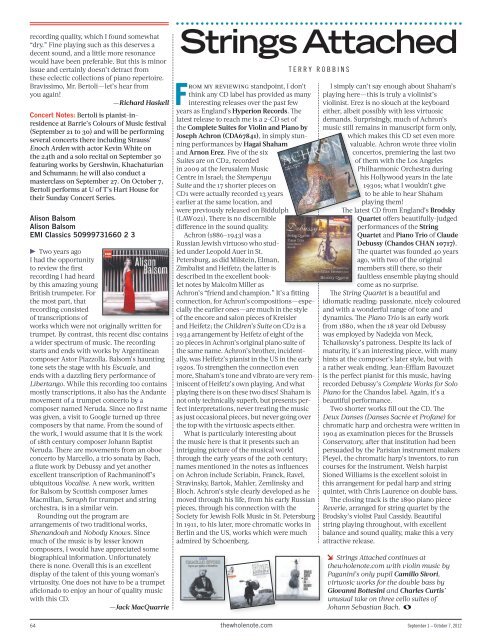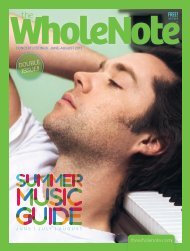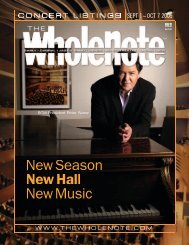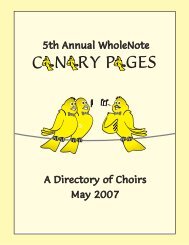PDF Version
PDF Version
PDF Version
- No tags were found...
You also want an ePaper? Increase the reach of your titles
YUMPU automatically turns print PDFs into web optimized ePapers that Google loves.
ecording quality, which I found somewhat“dry.” Fine playing such as this deserves adecent sound, and a little more resonancewould have been preferable. But this is minorissue and certainly doesn’t detract fromthese eclectic collections of piano repertoire.Bravissimo, Mr. Bertoli — let’s hear fromyou again!—Richard HaskellConcert Notes: Bertoli is pianist-inresidenceat Barrie’s Colours of Music festival(September 21 to 30) and will be performingseveral concerts there including Strauss’Enoch Arden with actor Kevin White onthe 24th and a solo recital on September 30featuring works by Gershwin, Khachaturianand Schumann; he will also conduct amasterclass on September 27. On October 7,Bertoli performs at U of T’s Hart House fortheir Sunday Concert Series.Alison BalsomAlison BalsomEMI Classics 50999731660 2 3!!Two years agoI had the opportunityto review the firstrecording I had heardby this amazing youngBritish trumpeter. Forthe most part, thatrecording consistedof transcriptions ofworks which were not originally written fortrumpet. By contrast, this recent disc containsa wider spectrum of music. The recordingstarts and ends with works by Argentineancomposer Astor Piazzolla. Balsom’s hauntingtone sets the stage with his Escuale, andends with a dazzling fiery performance ofLibertango. While this recording too containsmostly transcriptions, it also has the Andantemovement of a trumpet concerto by acomposer named Neruda. Since no first namewas given, a visit to Google turned up threecomposers by that name. From the sound ofthe work, I would assume that it is the workof 18th century composer Johann BaptistNeruda. There are movements from an oboeconcerto by Marcello, a trio sonata by Bach,a flute work by Debussy and yet anotherexcellent transcription of Rachmaninoff’subiquitous Vocalise. A new work, writtenfor Balsom by Scottish composer JamesMacmillan, Seraph for trumpet and stringorchestra, is in a similar vein.Rounding out the program arearrangements of two traditional works,Shenandoah and Nobody Knows. Sincemuch of the music is by lesser knowncomposers, I would have appreciated somebiographical information. Unfortunatelythere is none. Overall this is an excellentdisplay of the talent of this young woman’svirtuosity. One does not have to be a trumpetaficionado to enjoy an hour of quality musicwith this CD.—Jack MacQuarrieStrings AttachedFrom my reviewing standpoint, I don’tthink any CD label has provided as manyinteresting releases over the past fewyears as England’s Hyperion Records. Thelatest release to reach me is a 2-CD set ofthe Complete Suites for Violin and Piano byJoseph Achron (CDA67841), in simply stunningperformances by Hagai Shahamand Arnon Erez. Five of the sixSuites are on CD2, recordedin 2009 at the Jerusalem MusicCentre in Israel; the StempenyuSuite and the 17 shorter pieces onCD1 were actually recorded 13 yearsearlier at the same location, andwere previously released on Biddulph(LAW021). There is no discernibledifference in the sound quality.Achron (1886–1943) was aRussian Jewish virtuoso who studiedunder Leopold Auer in St.Petersburg, as did Milstein, Elman,Zimbalist and Heifetz; the latter isdescribed in the excellent bookletnotes by Malcolm Miller asAchron’s “friend and champion.” It’s a fittingconnection, for Achron’s compositions — especiallythe earlier ones — are much in the styleof the encore and salon pieces of Kreislerand Heifetz; the Children’s Suite on CD2 is a1934 arrangement by Heifetz of eight of the20 pieces in Achron’s original piano suite ofthe same name. Achron’s brother, incidentally,was Heifetz’s pianist in the US in the early1920s. To strengthen the connection evenmore, Shaham’s tone and vibrato are very reminiscentof Heifetz’s own playing. And whatplaying there is on these two discs! Shaham isnot only technically superb, but presents perfectinterpretations, never treating the musicas just occasional pieces, but never going overthe top with the virtuosic aspects either.What is particularly interesting aboutthe music here is that it presents such anintriguing picture of the musical worldthrough the early years of the 20th century;names mentioned in the notes as influenceson Achron include Scriabin, Franck, Ravel,Stravinsky, Bartok, Mahler, Zemlinsky andBloch. Achron’s style clearly developed as hemoved through his life, from his early Russianpieces, through his connection with theSociety for Jewish Folk Music in St. Petersburgin 1911, to his later, more chromatic works inBerlin and the US, works which were muchadmired by Schoenberg.TERRY ROBBINSI simply can’t say enough about Shaham’splaying here — this is truly a violinist’sviolinist. Erez is no slouch at the keyboardeither, albeit possibly with less virtuosicdemands. Surprisingly, much of Achron’smusic still remains in manuscript form only,which makes this CD set even morevaluable. Achron wrote three violinconcertos, premiering the last twoof them with the Los AngelesPhilharmonic Orchestra duringhis Hollywood years in the late1930s; what I wouldn’t giveto be able to hear Shahamplaying them!The latest CD from England’s BrodskyQuartet offers beautifully-judgedperformances of the StringQuartet and Piano Trio of ClaudeDebussy (Chandos CHAN 10717).The quartet was founded 40 yearsago, with two of the originalmembers still there, so theirfaultless ensemble playing shouldcome as no surprise.The String Quartet is a beautiful andidiomatic reading: passionate, nicely colouredand with a wonderful range of tone anddynamics. The Piano Trio is an early workfrom 1880, when the 18 year old Debussywas employed by Nadejda von Meck,Tchaikovsky’s patroness. Despite its lack ofmaturity, it’s an interesting piece, with manyhints at the composer’s later style, but witha rather weak ending. Jean-Efflam Bavouzetis the perfect pianist for this music, havingrecorded Debussy’s Complete Works for SoloPiano for the Chandos label. Again, it’s abeautiful performance.Two shorter works fill out the CD. TheDeux Danses (Danses Sacrée et Profane) forchromatic harp and orchestra were written in1904 as examination pieces for the BrusselsConservatory, after that institution had beenpersuaded by the Parisian instrument makersPleyel, the chromatic harp’s inventors, to runcourses for the instrument. Welsh harpistSioned Williams is the excellent soloist inthis arrangement for pedal harp and stringquintet, with Chris Laurence on double bass.The closing track is the 1890 piano pieceReverie, arranged for string quartet by theBrodsky’s violist Paul Cassidy. Beautifulstring playing throughout, with excellentbalance and sound quality, make this a veryattractive release.Strings Attached continues atthewholenote.com with violin music byPaganini’s only pupil Camillo Sivori,virtuosic works for the double bass byGiovanni Bottesini and Charles Curtis’unusual take on three cello suites ofJohann Sebastian Bach.64 thewholenote.com September 1 – October 7, 2012
















